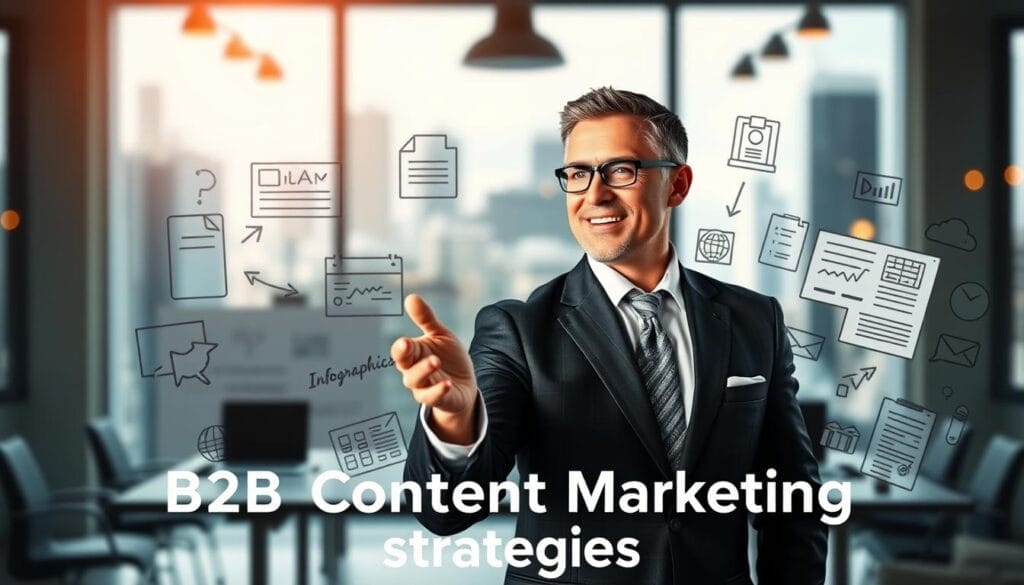In today’s business world, generic outreach just doesn’t cut it. With bigger buying committees and longer sales cycles, companies need targeted strategies to stand out. Decision-makers want personalized experiences, not generic pitches.
The move to account-based approaches has changed the game in complex sales. Instead of casting wide nets, teams now focus on high-value accounts with custom messages. This approach boosts efficiency and builds stronger relationships with key stakeholders.
But how do you get started? Effective campaigns use data and storytelling together. They align marketing and sales teams, using tools like predictive analytics to find the best clients. The best part? These strategies work for both big companies and niche industries.
Key Takeaways
- Personalized outreach outperforms generic campaigns in today’s competitive market
- Account-based strategies reduce wasted resources and improve conversion rates
- Cross-department alignment is critical for executing complex sales plays
- Data analytics tools help prioritize high-potential accounts
- Adaptability separates thriving teams from those stuck in outdated methods
Growth-focused organizations lead by creating trends, not just following them. By mixing proven methods with new tech, you can turn challenges into chances. Let’s dive into building campaigns that deliver real results at every step of the buyer’s journey.
Understanding B2B Marketing Fundamentals
B2B and B2C marketing have different goals and methods. B2B marketing is like planning a big merger, while B2C is like buying a latte. Let’s dive into what makes B2B marketing unique and challenging.
What Makes B2B Different From B2C Marketing
Think about selling enterprise software versus a smartphone. The challenges and timelines are vastly different:
Longer Sales Cycles & Complex Decision-Making
B2B sales take 6-12 months with many approvals. For instance, Salesforce sells CRM solutions to:
- IT teams checking technical needs
- Finance teams looking at ROI
- Executives considering strategic fit
| Factor | B2B Example | B2C Example |
|---|---|---|
| Average Decision Makers | 5-11 stakeholders | 1-2 individuals |
| Typical Timeframe | 3-18 months | 24 hours |
| Key Influencers | Technical experts, CFOs | Social media, ads |
Relationship-Driven vs Impulse Purchases
Unlike buying shoes from a TikTok ad, 89% of B2B buyers value trust over price. Companies like HubSpot build trust through:
- Regular business reviews
- Co-branded webinars
- Dedicated customer success teams
Key Components of Successful B2B Marketing
“The best B2B marketers don’t sell products – they sell measurable outcomes.”
Account-Based Marketing Strategies
Top marketers use ABM to target key accounts. Effective strategies include:
- Creating personalized video demos
- Hosting executive roundtables
- Developing account-specific ROI calculators
Value Proposition Development
A strong value proposition answers “Why us?” clearly. Cisco’s “Bridge to Possible” campaign was successful by:
- Showing 30% faster deployment times
- Offering 24/7 global support
- Highlighting tool integration
Building a Robust B2B Marketing Strategy
Creating a top-notch B2B marketing strategy means targeting well and using many channels. We’ll show you how to make your marketing plan fit the needs of B2B buyers.

Identifying Your Ideal Customer Profile
Your marketing starts with clear targeting. Focus on two main ways:
Firmographic vs Behavioral Targeting
Firmographic targeting uses company data like:
- Industry vertical
- Annual revenue
- Employee count
Behavioral targeting looks at how people engage, such as:
- Content they read
- Technology they use
- How active they are in making decisions
| Criteria Firmographic Behavioral | ||
| Data Source | Company registries, SEC filings | CRM analytics, website tracking |
| Best For | Account list creation | Lead scoring prioritization |
| Example | Targeting $50M+ manufacturing firms | Engaging CTOs reading whitepapers |
Creating Multi-Touch Campaigns
Today’s B2B buyers need 8+ touchpoints to buy. Mix channels wisely:
Combining Digital and Traditional Channels
- Use LinkedIn Ads with personalized emails
- Follow up trade shows with video demos
- Support webinars with direct mail
“The best campaigns mix digital speed with traditional trust – it’s about finding the right balance.”
Lead Nurturing Best Practices
Try this automation sequence:
- Send educational content within 1 hour of lead capture
- Share case studies 3 days later
- Offer consultation 7 days after engagement
Watch how people respond to adjust your timing. Slow ones might need monthly checks, while fast ones need weekly updates.
Content Marketing for B2B Success
In the competitive B2B world, content marketing is key. It builds trust and brings in quality leads. Unlike ads, it makes your brand a leader in your field. It also solves specific problems. Let’s see how to make thought leadership content and make it search engine friendly.

Developing Thought Leadership Content
White papers and case studies are vital for B2B decisions. Cisco’s case study on hybrid cloud solutions, for example, increased their conversion rate by 30%. It showed clear ROI for big clients. SAP’s white paper on AI in supply chains also worked well, getting 2,000+ leads in three months.
When making these pieces:
- Use data and insights, not just sales talk
- Add testimonials and third-party checks
- Give practical advice, not just ideas
Webinar Hosting Best Practices
Webinars can turn 15-20% of viewers into leads if done right. Promote them with:
- LinkedIn Ads targeting specific jobs and fields
- Email campaigns with interesting previews
- Content bundles for those who missed the event
| Content Type | Example | Avg. Conversion Rate | Key Benefit |
|---|---|---|---|
| Case Study | Cisco Cloud Migration | 28% | Proves ROI |
| Webinar | SAP AI Workshop | 18% | Live Engagement |
| White Paper | Data Security Trends | 22% | Lead Capture |
SEO Strategies for B2B Companies
B2B buyers search 12+ times before choosing a vendor. Help them find you with these tips:
Long-Tail Keyword Optimization
Use tools like SEMrush to find specific phrases. Instead of “cloud migration,” use “enterprise cloud migration checklist.” These longer phrases:
- Bring 50% more relevant traffic
- Cost 30% less in Google Ads
- Convert 2x better than broad terms
Technical SEO for Lead Generation
Fix these key areas to improve your site’s visibility:
- Mobile-first indexing: Keep pages under 2 seconds to load
- SSL certificates: 82% of B2B buyers won’t visit non-HTTPS sites
- Structured data markup for whitepapers and product sheets
Email Marketing That Converts
Email is the highest-ROI marketing tactic for B2B companies when done right. A good campaign can bring in $42 for every $1 spent. Success depends on quality contacts and strategic messaging.
Building High-Quality Contact Lists
Blanket email blasts can hurt your reputation fast. Smart B2B marketers grow lists through permission-based acquisition:
- Gated industry reports that solve specific pain points
- Webinar sign-ups with actionable takeaways
- Free toolkits (e.g., ROI calculators, vendor scorecards)
Permission-Based Acquisition Tactics
Event marketing is key for high-performing email lists. After a virtual summit, one SaaS company saw:
| Tactic | Contacts Gained | Conversion Rate |
|---|---|---|
| Post-event follow-up | 1,200 | 6% |
| Content upgrades | 890 | 4.5% |
| LinkedIn retargeting | 430 | 3.1% |
Crafting Effective B2B Email Sequences
Decision-makers get 121 emails daily. Stand out with hyper-relevant messaging that mirrors their buying journey.
Personalization Techniques That Work
Dynamic content boosts open rates by 26%. Instead of “Hi [First Name],” try:
“Hi [First Name], as [Job Title] at [Company], you’ll want to see how [Industry-Specific Pain Point] impacts…”
Top performers use firmographic data to tailor content.
Call-to-Action Optimization
A/B tests show surprising patterns. “Schedule Demo” works for early-stage leads, but “See Your Custom ROI Estimate” converts 18% better with executives. Place primary CTAs:
- After explaining measurable outcomes
- Before pricing details
- With contrasting button colors (orange outperforms blue by 9%)
Leveraging Emerging B2B Marketing Trends
The future of B2B marketing combines AI with immersive content. This attracts decision-makers. Companies that use these trends first get ahead by giving personalized experiences to many. Let’s look at two big trends changing how marketing teams talk to today’s buyers.
AI-Powered Account Targeting
Tools like 6sense analyze huge amounts of data. They find companies looking for solutions like yours. This helps marketing teams focus on the most promising accounts.
Predictive Analytics Implementation
Begin by linking AI with your CRM. For example, Drift’s tools automatically connect high-intent visitors with sales reps. A manufacturing client saw a 37% increase in good leads in just three months.

Interactive Content Experiences
Static PDFs are outdated. Now, top B2B brands use dynamic tools. These let prospects learn while you gather important data.
ROI Calculators and Configurators
Siemens saw a 28% boost in conversions with their ROI calculator. These tools show buyers how they can save money. This makes value clear before talking to sales.
Virtual Product Demonstrations
IBM cut sales cycles by 19% with 3D demos. Here’s how to start:
- Choose demo scenarios that solve buyer problems
- Use analytics to track user actions
- Train sales teams to use this data
These new marketing tools make lasting impressions and give your team useful data. The secret? Begin small, track closely, and grow what succeeds.
Essential B2B Marketing Tools
The right tools can make a big difference. They help manage pipelines and automate workflows. They also help meet your marketing funnel goals.
CRM Platforms for Pipeline Management
Customer relationship management systems are key for B2B marketing techniques. Two top players stand out:
Salesforce vs HubSpot Comparison
| Feature | Salesforce | HubSpot |
|---|---|---|
| Entry Price | $25/user/month | $45/month |
| Best For | Enterprise teams | Mid-market companies |
| Key Integration | Microsoft Dynamics | Shopify |
Salesforce is great for complex sales cycles. HubSpot is better for one business teams that handle marketing and sales.
Marketing Automation Solutions
Automation makes tasks more efficient. Here’s how to use these marketing tools effectively:
Workflow Creation Best Practices
- Start with trade show follow-up templates (trigger: form submission)
- Add delay timers between touchpoints
- Include sales team notification steps
Lead Scoring Models
| Behavior | Points | Sales Readiness |
|---|---|---|
| Whitepaper Download | +5 | Early Stage |
| Pricing Page Visit | +15 | Decision Phase |
| Demo Request | +30 | Hot Lead |
Change scoring thresholds every quarter. This keeps your B2B marketing techniques up to date with real results.
Conclusion: Sustaining B2B Marketing Success
Effective b2b marketing campaigns need constant improvement. Start by making marketing teams work together with sales. Use tools like Salesforce CRM or HubSpot’s ABM suite to track how well your marketing is doing.
Focus on account-based experience strategies. Use predictive lead scoring and platforms like Demandbase to find the most valuable accounts. Add interactive content from Ion Interactive to engage customers better during long sales cycles.
Build ways to measure how well your marketing is doing. Use PathFactory’s analytics to see how content affects sales speed. Try Drift’s AI tools to make emails more relevant to your audience.
Do quarterly checks to keep your marketing fresh. Update your buyer personas with Bombora’s intent data. Train your team on new tools like LinkedIn’s ABX features. Use Notion or Confluence to keep everyone on the same page as your company grows.
Good b2b marketing mixes proven methods with new ideas. Focus on building strong relationships with your audience through valuable content. Use technology to automate routine tasks. This combination of tech and human touch leads to lasting success in tough markets.



Leave a Reply